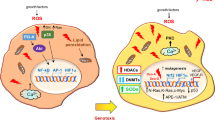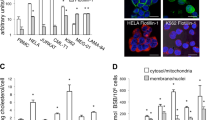Abstract
N-(4-hydroxyphenyl)retinamide (HPR) is a synthetic retinoid that inhibits growth of many human tumor cells, including those resistant to natural retinoids. HPR is an effective chemopreventive agent for prostate, cervix, breast, bladder, skin and lung cancers, and has shown promise for the treatment of neuroblastomas. We have previously shown that HPR inhibits proliferation and induces apoptosis of human T-cell lymphotropic virus type I (HTLV-I)-associated adult T-cell leukemia (ATL) and HTLV-I-negative malignant T cells, whereas no effect is observed on normal lymphocytes. In this report, we identified HPR-induced reactive oxygen species (ROS) generation as the key mediator of cell cycle arrest and apoptosis of malignant T cells. HPR treatment of HTLV-I-negative malignant T cells was associated with a rapid and progressive ROS accumulation. Pre-treatment with the antioxidants vitamin C and dithiothreitol inhibited ROS generation, prevented HPR-induced ceramide accumulation, cell cycle arrest, cytochrome c release, caspase-activation and apoptosis. Therefore, anti-oxidants protected malignant T cells from HPR-induced growth inhibition. The expression of the HTLV-I oncoprotein Tax abrogated HPR-induced ROS accumulation in HTLV-I-infected cells, which explains their lower sensitivity to HPR. Defining the mechanism of free radical induction by HPR may support a potential therapeutic role for this synthetic retinoid in ATL and HTLV-I-negative T-cell lymphomas.
This is a preview of subscription content, access via your institution
Access options
Subscribe to this journal
Receive 12 print issues and online access
$259.00 per year
only $21.58 per issue
Buy this article
- Purchase on Springer Link
- Instant access to full article PDF
Prices may be subject to local taxes which are calculated during checkout







Similar content being viewed by others
References
Delia D, Aiello A, Lombardi L, Pelicci PG, Grignani F, Grignani F et al. N-(4-hydroxyphenyl) retinamide induces apoptosis of malignant hemopoietic cell lines including those unresponsive to retinoic acid. Cancer Res 1993; 53: 6036–6041.
Bazarbachi A, Hermine O . Treatment of adult T-cell leukaemia/lymphoma: current strategy and future perspectives. Virus Res 2001; 78: 79–92.
Yoshida M . Multiple viral strategies of HTLV-1 for dysregulation of cell growth control. Annu Rev Immunol 2001; 19: 475–496.
Kfoury Y, Nasr R, Hermine O, de The H, Bazarbachi A . Proapoptotic regimes for HTLV-I-transformed cells: targeting Tax and the NF-kappaB pathway. Cell Death Differ 2005; 12: 871–877.
Bazarbachi A, Ghez D, Lepelletier Y, Nasr R, de The H, El-Sabban ME et al. New therapeutic approaches for adult T-cell leukaemia. Lancet Oncol 2004; 5: 664–672.
Darwiche N, Hatoum A, Dbaibo G, Kadara H, Nasr R, Abou-Lteif G et al. N-(4-hydroxyphenyl) retinamide induces growth arrest and apoptosis in HTLV-I-transformed cells. Leukemia 2004; 18: 607–615.
Oridate N, Suzuki S, Higuchi M, Mitchell MF, Hong WK, Lotan R . Involvement of reactive oxygen species in N-(4-hydroxyphenyl)retinamide-induced apoptosis in cervical carcinoma cells. J Natl Cancer Inst 1997; 89: 1191–1198.
DiPietrantonio AM, Hsieh TC, Juan G, Traganos F, Darzynkiewicz Z, Wu JM . Fenretinide-induced caspase 3 activity involves increased protein stability in a mechanism distinct from reactive oxygen species elevation. Cancer Res 2000; 60: 4331–4335.
Hail Jr N, Lotan R . Mitochondrial permeability transition is a central coordinating event in N-(4-hydroxyphenyl) retinamide-induced apoptosis. Cancer Epidemiol Biomarkers Prev 2000; 9: 1293–1301.
Darwiche N, Abou-Lteif G, Najdi T, Kozhaya L, Abou Tayyoun A, Bazarbachi A et al. Human T-cell lymphotropic virus type I-transformed T-cells have a partial defect in ceramide synthesis in response to N-(4-hydroxyphenyl)retinamide. Biochem J 2005; 392: 231–239.
Suzuki S, Higuchi M, Proske RJ, Oridate N, Hong WK, Lotan R . Implication of mitochondria-derived reactive oxygen species, cytochrome c and caspase-3 in N-(4-hydroxyphenyl)retinamide-induced apoptosis in cervical carcinoma cells. Oncogene 1999; 18: 6380–6387.
Boya P, Morales MC, Gonzalez-Polo RA, Andreau K, Gourdier I, Perfettini JL et al. The chemopreventive agent N-(4-hydroxyphenyl)retinamide induces apoptosis through mitochondrial pathway regulated by proteins from the Bcl-2 family. Oncogene 2003; 22: 6220–6230.
Ulukaya E, Pirianov G, Kurt MA, Wood EJ, Mehmet H . Fenretinide induces cytochrome c release, caspase 9 activation and apoptosis in the absence of mitochondrial membrane depolarisation. Cell Death Differ 2003; 10: 856–859.
Darwiche N, El-Sabban M, Bazzi, Nasr R, Al-Hashimi S, Hermine O et al. Retinoic acid dramatically enhances the arsenic trioxide-induced cell cycle arrest and apoptosis in retinoic acid receptor alpha-positive human T-cell lymphotropic virus type-I-transformed cells. Hematol J 2001; 2: 127–135.
Smith MR, Greene WC . Type I human T cell leukemia virus tax protein transforms rat fibroblasts through the cyclic adenosine monophosphate response element binding protein/activating transcription factor pathway. J Clin Invest 1991; 88: 1038–1042.
Hatoum A, El-Sabban ME, Khoury J, Yuspa SH, Darwiche N . Overexpression of retinoic acid receptors alpha and gamma into neoplastic epidermal cells causes retinoic acid-induced growth arrest and apoptosis. Carcinogenesis 2001; 22: 1955–1963.
Kharbanda S, Pandey P, Schofield L, Israels S, Roncinske R, Yoshida K et al. Role for Bcl-xL as an inhibitor of cytosolic cytochrome c accumulation in DNA damage-induced apoptosis. Proc Natl Acad Sci USA 1997; 94: 6939–6942.
Wu JM, DiPietrantonio AM, Hsieh TC . Mechanism of fenretinide (4-HPR)-induced cell death. Apoptosis 2001; 6: 377–388.
Mologni L, Ponzanelli I, Bresciani F, Sardiello G, Bergamaschi D, Gianni M et al. The novel synthetic retinoid 6-[3-adamantyl-4-hydroxyphenyl]-2-naphthalene carboxylic acid (CD437) causes apoptosis in acute promyelocytic leukemia cells through rapid activation of caspases. Blood 1999; 93: 1045–1061.
Kawakami A, Nakashima T, Sakai H, Urayama S, Yamasaki S, Hida A et al. Inhibition of caspase cascade by HTLV-I tax through induction of NF-kappaB nuclear translocation. Blood 1999; 94: 3847–3854.
Satoh E, Okada M, Takadera T, Ohyashiki T . Glutathione depletion promotes aluminum-mediated cell death of PC12 cells. Biol Pharm Bull 2005; 28: 941–946.
Delia D, Aiello A, Meroni L, Nicolini M, Reed JC, Pierotti MA . Role of antioxidants and intracellular free radicals in retinamide-induced cell death. Carcinogenesis 1997; 18: 943–948.
Hail Jr N, Lotan R . Mitochondrial respiration is uniquely associated with the prooxidant and apoptotic effects of N-(4-hydroxyphenyl)retinamide. J Biol Chem 2001; 276: 45614–45621.
Sun SY, Yue P, Lotan R . Induction of apoptosis by N-(4-hydroxyphenyl)retinamide and its association with reactive oxygen species, nuclear retinoic acid receptors, and apoptosis-related genes in human prostate carcinoma cells. Mol Pharmacol 1999; 55: 403–410.
Barna G, Sebestyen A, Weischede S, Petak I, Mihalik R, Formelli F et al. Different ways to induce apoptosis by fenretinide and all-trans-retinoic acid in human B lymphoma cells. Anticancer Res 2005; 25: 4179–4185.
Lovat PE, Corazzari M, Goranov B, Piacentini M, Redfern CP . Molecular mechanisms of fenretinide-induced apoptosis of neuroblastoma cells. Ann N Y Acad Sci 2004; 1028: 81–89.
Kim DG, You KR, Liu MJ, Choi YK, Won YS . GADD153-mediated anticancer effects of N-(4-hydroxyphenyl)retinamide on human hepatoma cells. J Biol Chem 2002; 277: 38930–38938.
Kim HJ, Chakravarti N, Oridate N, Choe C, Claret FX, Lotan R . N-(4-Hydroxyphenyl) retinamide-induced apoptosis triggered by reactive oxygen species is mediated by activation of MAPKs in head and neck squamous carcinoma cells. Oncogene 2006; 25: 2785–2794.
Jeang KT . Functional activities of the human T-cell leukemia virus type I Tax oncoprotein: cellular signaling through NF-kappa B. Cytokine Growth Factor Rev 2001; 12: 207–217.
Cereseto A, Diella F, Mulloy JC, Cara A, Michieli P, Grassmann R et al. p53 functional impairment and high p21waf1/cip1 expression in human T-cell lymphotropic/leukemia virus type I-transformed T cells. Blood 1996; 88: 1551–1560.
Kawata S, Ariumi Y, Shimotohno K . p21(Waf1/Cip1/Sdi1) prevents apoptosis as well as stimulates growth in cells transformed or immortalized by human T-cell leukemia virus type 1-encoded tax. J Virol 2003; 77: 7291–7299.
Acknowledgements
This work was supported by grants from the Lebanese National Council for Scientific Research and the American University of Beirut University Research Board and Medical Practice Plan.
Author information
Authors and Affiliations
Corresponding authors
Rights and permissions
About this article
Cite this article
Darwiche, N., Abou-Lteif, G. & Bazarbachi, A. Reactive oxygen species mediate N-(4-hydroxyphenyl)retinamide-induced cell death in malignant T cells and are inhibited by the HTLV-I oncoprotein Tax. Leukemia 21, 261–269 (2007). https://doi.org/10.1038/sj.leu.2404472
Received:
Revised:
Accepted:
Published:
Issue Date:
DOI: https://doi.org/10.1038/sj.leu.2404472
Keywords
This article is cited by
-
N-(4-hydroxyphenyl)retinamide promotes apoptosis of resting and proliferating B-cell chronic lymphocytic leukemia cells and potentiates fludarabine and ABT-737 cytotoxicity
Leukemia (2012)
-
Reduced levels of reactive oxygen species correlate with inhibition of apoptosis, rise in thioredoxin expression and increased bovine leukemia virus proviral loads
Retrovirology (2009)
-
HTLV-1 Tax protein cooperates with Ras in protecting cells from apoptosis
Apoptosis (2009)
-
HTLV-1 and apoptosis: role in cellular transformation and recent advances in therapeutic approaches
Apoptosis (2008)



